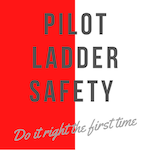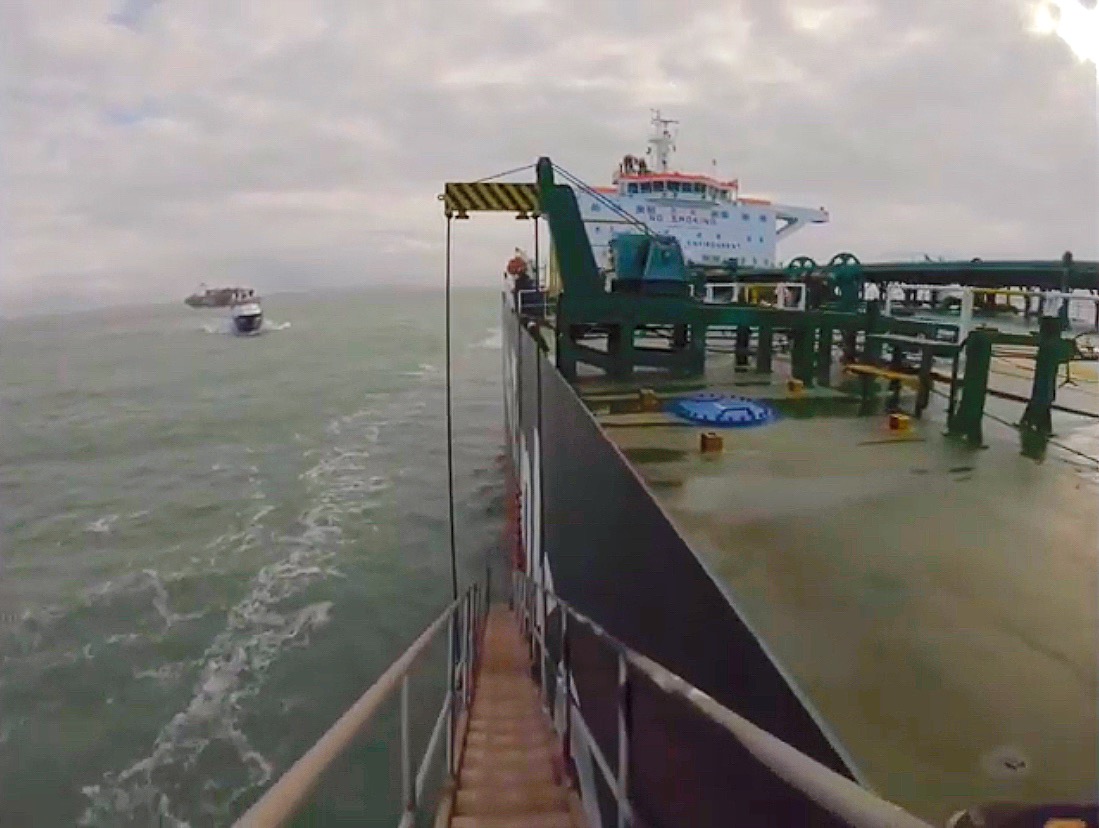The use of a combination ladder, an accommodation ladder as well as a pilot ladder, is needed when the freeboard of the ship is more than 9 meters. It is important to allow a free space of more than 5 meters under the platform of the accommodation ladder, to let the pilot boat come alongside safely.
The pilot ladder must extend at least 2 meters above the platform of the accommodation ladder, so that the pilot can safely transfer from the pilot ladder to the platform of the accommodation ladder, vice versa.
The Accomodationladder and the Pilotladder must be secured to the ship side independent of each other
Since this type of combination ladder is often used on empty tankers, the rolling of the vessel can be considerable. For this reason, it is very important that the pilot ladder, as well as the accommodation ladder are well secured to the ships side, independent of each other.Climbing or descending a pilot ladder which is swinging away from the ship’s hull is very dangerous. The securing of the pilot ladder to the ship’s hull should be placed 1,5 meters above the platform of the accommodation ladder, one lashing on each side rope.
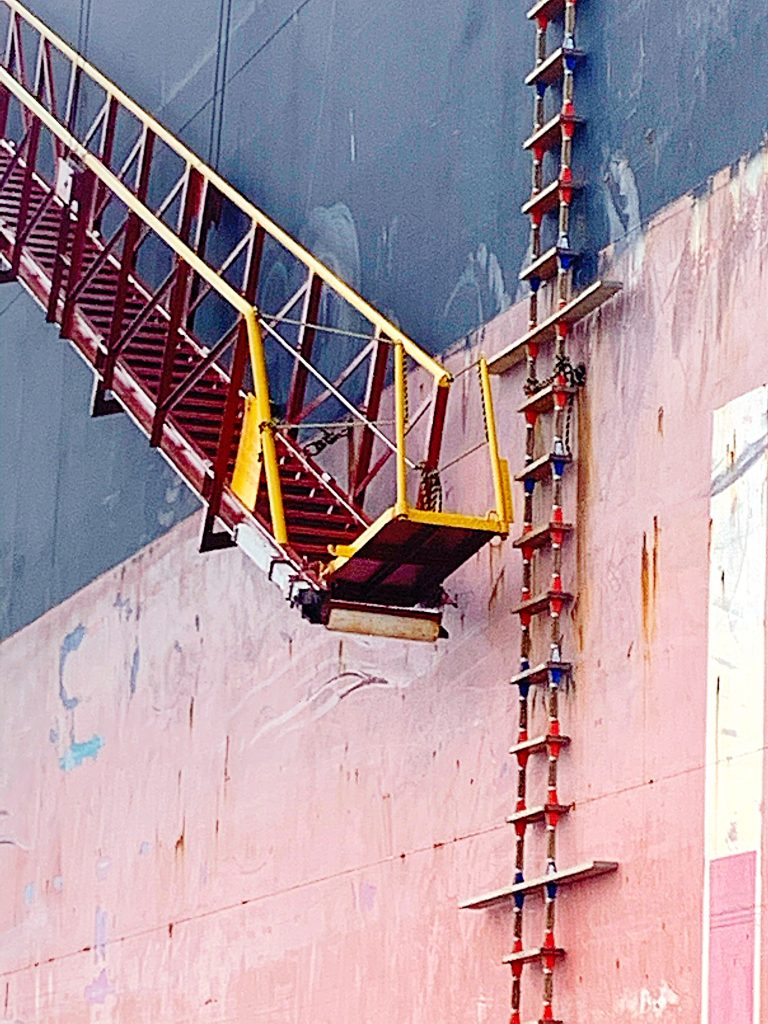
In the previous picture, the inner stanchion on the bottom platform is rigged in place, as it should be. The below two pictures show what happens when the inner stanchion is not used: on the final step of his descend onto the platform, he has only one hand to hold his balance. That could be fatal when the ship takes a sudden roll. Always secure the inner stanchion in place!
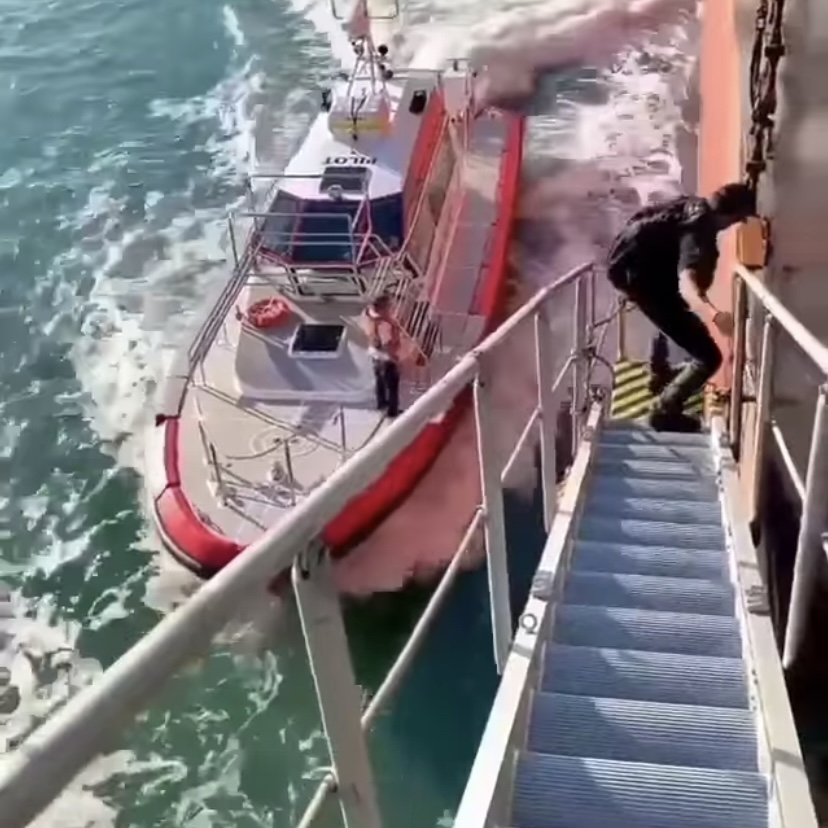
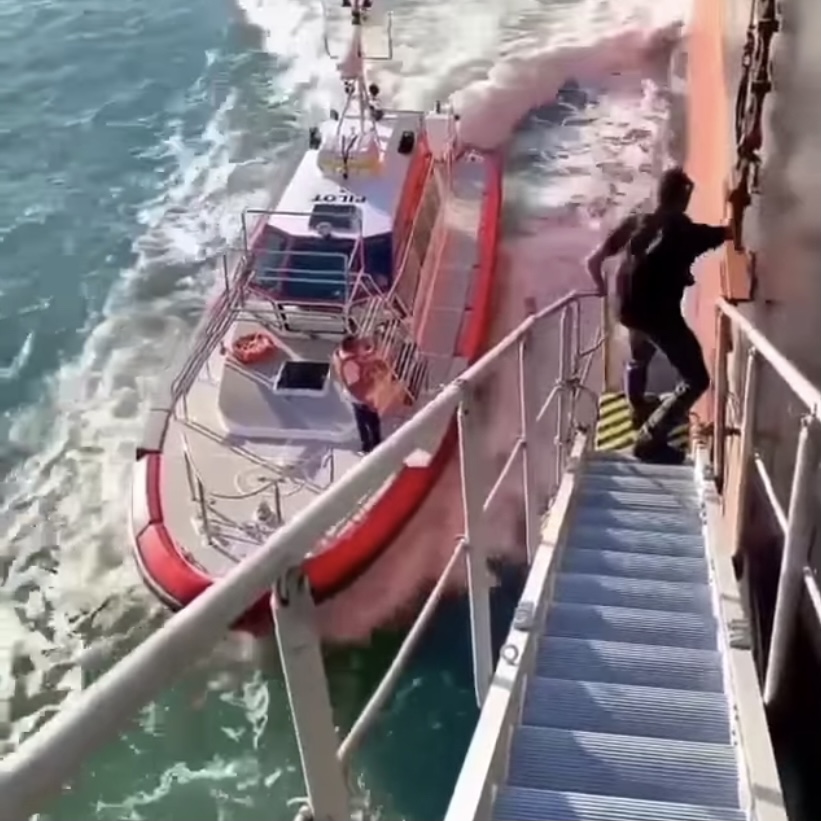
On the final step to the platform and onto the pilot ladder, the pilot has only one hand to hold himself if the inboard stanchion is not in place. (Source: Sea and Coast Magazine , via Facebook)
In the next picture, the pilot embarks a vessel using a combination ladder. The first thing he grabs when he steps off the pilot ladder onto the accomodation ladder is: the inner stanchion. It is the closest to the pilot ladder and that’s why it is very important for getting balance when stepping onto the platform.
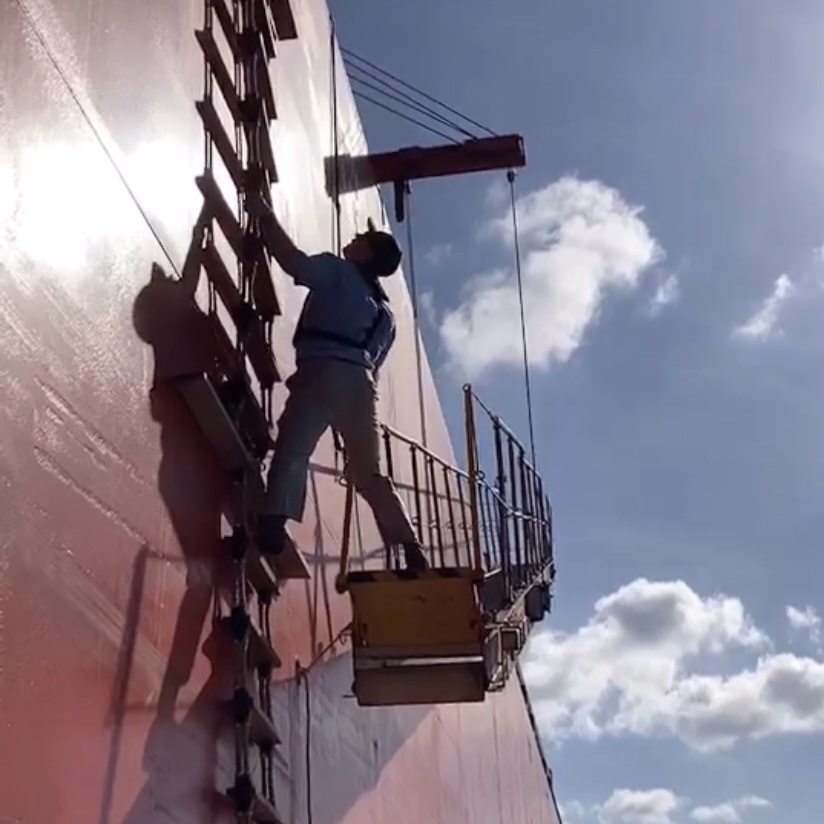
On the IMO’s Wheelhouse poster, all important information is given on the correct rigging and dimensions of a combination ladder.
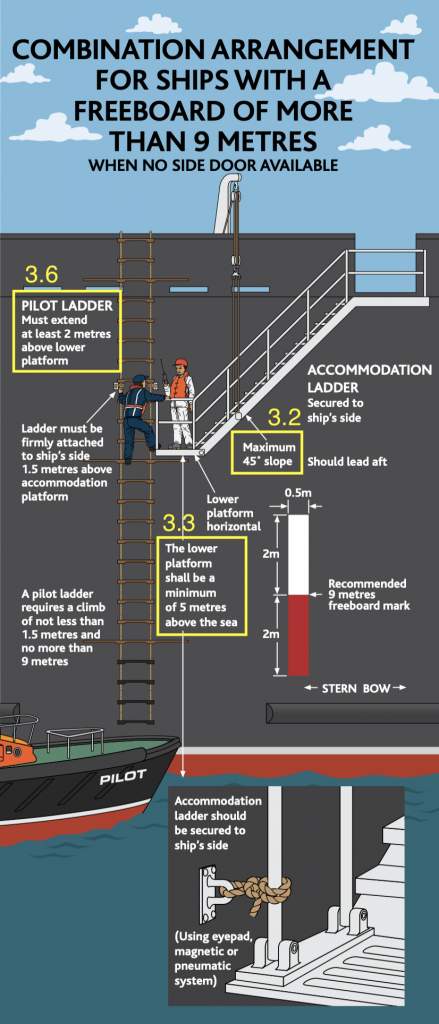
Trapdoor arrangement
One very special kind of combination ladder arrangement is the so-called trapdoor arrangement.
Many pilots do not like to use this system, because it requires a lot of acrobatics to embark or disembark the ship. In december 2019 a New York pilot died when boarding a ship with this system, which attracted a lot of attention in the press.
SOLAS regulations are very clear about this type of arrangement:
” In the case of a combination arrangement using an accommodation ladder with a trapdoor in the bottom platform (i.e. embarkation platform), the pilot ladder and man ropes shall be rigged through the trapdoor extending above the platform to the height of the handrail.”
This clearly makes many trapdoor arrangements, such as the one in the below picture non-compliant.
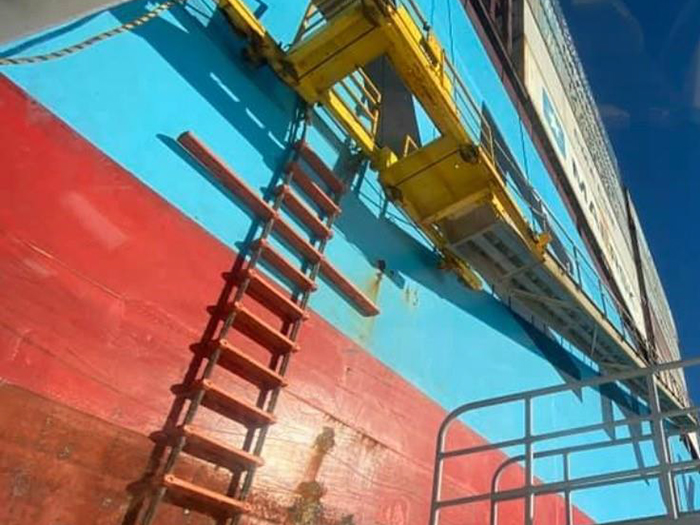
To address the above problems, in 2020 there have been modifications to this system on some ships, which solves the above problems, provided that the system is secured to the ship’s hull on the level of the platform. The below picture shows how a compliant trapdoor arrangement should look like.
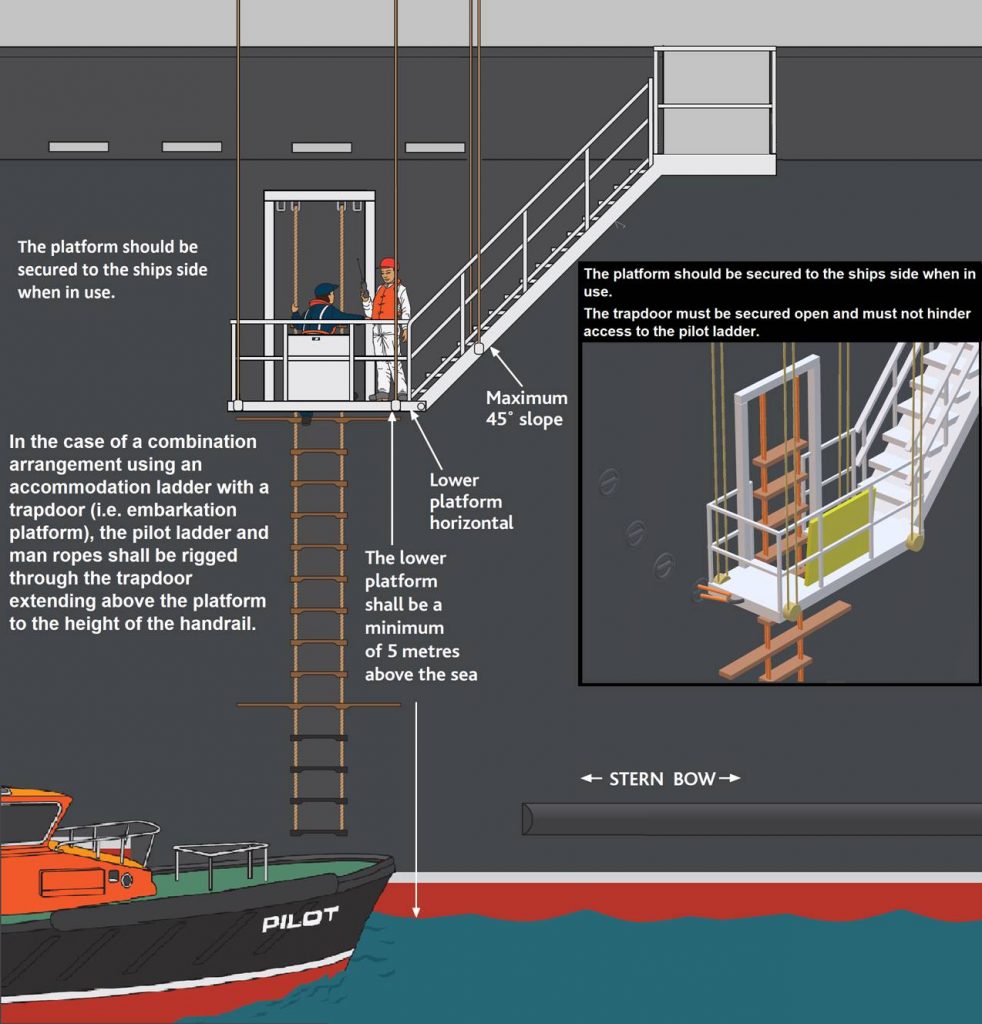
The Safe Working Load (SWL) of the winch that holds the platform arrangement, must at least be a SWL of sufficient strength to cope with the weight of the platform, accomodation ladder, max number of persons on the arrangement plus 96kN. Also a mechanical locking device must be in place and used.
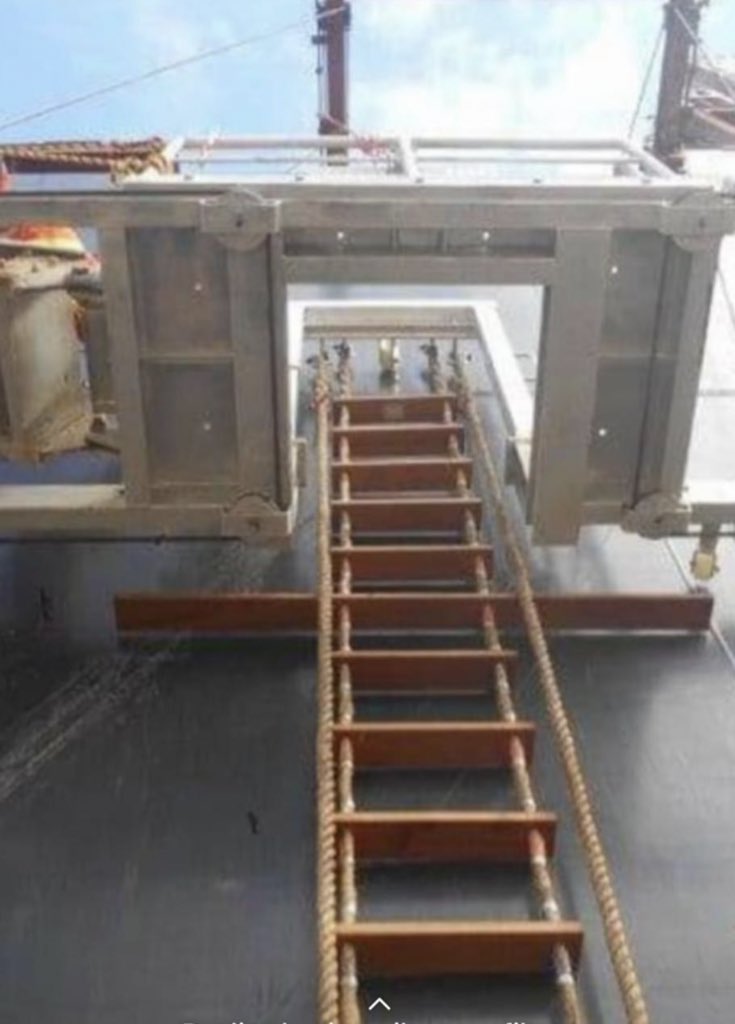
TEST YOUR KNOWLEDGE ABOUT THIS SECTION OF THE WEBSITE (CLICK HERE)
SOLAS V – Reg 23
Transfer Arrangements
3.3: Safe and convenient access to, and egress from, the ship shall be provided by either:
.2. an accommodation ladder in conjunction with the pilot ladder (i.e. a combination arrangement), or other equally safe and convenient means, whenever the distance from the surface of the water to the point of access to the ship is more than 9 m. The accommodation ladder shall be sited leading aft. When in use, means shall be provided to secure the lower platform of the accommodation ladder to the ship’s side, so as to ensure that the lower end of the accommodation ladder and the lower platform are held firmly against the ship’s side within the parallel body length of the ship and, as far as is practicable, within the mid-ship half length and clear of all discharges.
.1. when a combination arrangement is used for pilot access, means shall be provided to secure the pilot ladder and manropes to the ship’s side at a point of nominally 1.5 m above the bottom platform of the accommodation ladder. In the case of a combination arrangement using an accommodation ladder with a trapdoor in the bottom platform (i.e. embarkation platform), the pilot ladder and man ropes shall be rigged through the trapdoor extending above the platform to the height of the handrail.
IMO 1045(27) Pilot Transfer Arrangements:
3 Accommodation ladders used in conjunction with pilot ladders
3.1 Arrangements which may be more suitable for special types of ships may be accepted, provided that they are equally safe.
3.2 The length of the accommodation ladder should be sufficient to ensure that its angle of slope does not exceed 45°. In ships with large draft ranges, several pilot ladder hanging positions may be provided, resulting in lesser angles of slope. The accommodation ladder should be at least 600 mm in width.
3.3 The lower platform of the accommodation ladder should be in a horizontal position and secured to the ship’s side when in use. The lower platform should be a minimum of 5 m above sea level.
3.4 Intermediate platforms, if fitted, should be self-levelling. Treads and steps of the accommodation ladder should be so designed that an adequate and safe foothold is given at the operative angles.
3.5 The ladder and platform should be equipped on both sides with stanchions and rigid handrails, but if handropes are used they should be tight and properly secured. The vertical space between the handrail or handrope and the stringers of the ladder should be securely fenced.
3.6 The pilot ladder should be rigged immediately adjacent to the lower platform of the accommodation ladder and the upper end should extend at least 2 m above the lower platform. The horizontal distance between the pilot ladder and the lower platform should be between 0.1 and 0.2 m.
3.7 If a trapdoor is fitted in the lower platform to allow access from and to the pilot ladder, the aperture should not be less than 750 mm x 750 mm. The trapdoor should open upwards and be secured either flat on the embarkation platform or against the rails at the aft end or outboard side of the platform and should not form part of the handholds. In this case the after part of the lower platform should also be fenced as specified in paragraph 3.5 above, and the pilot ladder should extend above the lower platform to the height of the handrail and remain in alignment with and against the ship’s side.
3.8 Accommodation ladders, together with any suspension arrangements or attachments fitted and intended for use in accordance with this recommendation, should be to the satisfaction of the Administration1.
1Refer to SOLAS regulation II-1/3-9 concerning accommodation ladders.
SOLAS II-1/3-9:
Regulation 3-9. Means of embarkation on and disembarkation from ships
- Ships constructed on or after 1 January 2010 shall be provided with means of embarkation on and disembarkation from ships for use in port and in port related operations, such as gangways and accommodation ladders, in accordance with paragraph 2, unless the Administration deems that compliance with a particular provision is unreasonable orimpractical .
- The means of embarkation and disembarkation required in paragraph 1 shall be constructed and installed based on the guidelines developed by the Organization .
- For all ships the means of embarkation and disembarkation shall be inspected and maintained in suitable condition for their intended purpose, taking into account any restrictions related to safe loading. All wires used to support the means of embarkation and disembarkation shall be maintained as specified in regulation III/20.4.:
Regulation 20.4 Operational readiness, maintenance and inspections: Maintenance of falls
Falls used in launching shall be inspected periodically with special regard for areas passing through sheaves, and renewed when necessary due to deterioration of the falls or at intervals of not more than 5 years, whichever is the earlier.
